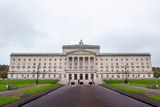New renewable heat initiative at Stormont gets green light


The Department for the Economy is to set up a renewable heat initiative — in the grounds of Stormont itself.
Unlike the last one, this one probably won’t bring down the government.
An experiment in sourcing sustainable and secure energy underground is to be held in the grounds of the east Belfast estate.
At the recent meeting of the Belfast City Council Planning Committee, councillors approved a “short duration geothermal ground source heating demonstration project” on lands at Stormont Estate, Upper Newtownards Road.
It will comprise shallow drilling, the testing and completion of five exploratory boreholes, associated temporary access, and the setting up of a mobile public information kiosk.
The applicant was Stormont’s Department for the Economy, whose predecessor – the Department of Enterprise, Trade and Investment – was behind the scandal-hit Renewable Heat Initiative that led to the collapse of power-sharing in January 2017.
Council officers recommended the geothermal plan to elected members, and there were no objections from any of the statutory consultees.
The proposal is located in the south-eastern part of the estate, on “white unzoned” land, that is, land not set aside for development.
The proposal includes drilling four boreholes each to a depth of up to 250m and one cored borehole to a depth of up to 500m deep.
The aim of the project is to conduct geothermal exploratory and feasibility studies in accordance with the actions set out within the Northern Ireland Energy Strategy (Path to Net Zero Energy).
The council report states: “This project will identify suitable drill sites then drill and test the water and rocks in five shallow exploratory boreholes within the Stormont Estate.
“This location at Stormont has been chosen because it sits on top of a productive aquifer, with shallow geothermal potential for both closed-loop and open-loop geothermal systems.”
Geothermal is seen as one of the most environmentally friendly ways of producing locally sustainable and renewable energy, as it harnesses the heat which is continuously produced inside the earth.
Energy is naturally stored as heat in rocks and waters within the Earth’s subsurface.
Low temperature heat from shallow depths is used mostly by transferring heat from the rocks to a circulating fluid in a pipe, which can be extracted and further warmed using a heat pump.
The heat exchange processes can also operate in reverse and transfer excess heat back to the subsurface, thereby cooling buildings.
Water can be brought to the surface as a direct heat source or it can be used to create steam that can power a turbine and generate electricity.
Geothermal energy is very different to fracking. Geothermal projects circulate fresh water in pre-existing pore spaces and fractures beneath the earth’s surface, and once the heat has been extracted and used, the water is re-injected into the same formation to allow it to re-heat.
Fracking is where rock is deliberately fractured under pressure to enable gas to be extracted.
The council report states: “The aim of this geothermal project is to capture natural heat and use it as renewable energy, to assist with moving away from fossil fuel use.
“The Stormont Estate proposal intends to prove that a shallow geothermal system can provide efficient, affordable, heating, cooling and thermal storage to help decarbonise and reduce the cost of heating buildings not only on the estate, but elsewhere.
“The proposed borehole sites are located on or close to existing car parks which are low lying with flat topography. They are situated in locations which will not be visible from public viewpoints on the Upper Newtownards Road.
“Renewable energy development is a material consideration. The consultation responses from Environmental Health and DAERA indicate the proposal will not result in an unacceptable adverse impact on human health, visual amenity, nature conservation or natural resources.”
Join the Belfast Telegraph WhatsApp channel
Stay up to date with some of Northern Ireland's biggest stories


